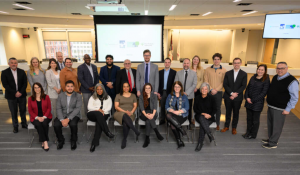Cleveland’s inner-ring suburbs are looking to identify zoning issues and outline best practices for making the construction of infill housing more achievable throughout Cuyahoga County by updating, in some cases, turn-of-the-century zoning codes.
Infill housing — new residential development on vacant, abandoned and underutilized property within built-up areas of existing communities — is a common housing strategy deployed by local community development corporations and established suburban communities. First suburbs are often built-out communities with only smaller, scattered vacant lots available; thus, infill construction on these lots becomes important to meet housing demand and diversify the local housing stock.
This type of development, however, is often difficult, and vacant lots are left unbuilt due to outdated regulations and complicated processes. For example, zoning regulations can often stand in the way of single-family infill construction. This type of construction occurs on individual lots that can often be smaller and tighter than zoning codes allow and can add time and additional costs to projects.
The Single-Family Housing Zoning Analysis, a project of the Northeast Ohio First Suburbs Consortium, in partnership with funding from the Cuyahoga Land Bank and supported financially by First Federal Lakewood, aims to assist inner-ring communities in expanding single-family infill development by identifying issues within zoning and outlining best practices for constructing desired infill housing more practicably.
“Regional problems need regional partners,” says Jennifer Kuzma, Director of the Northeast Ohio First Suburbs Consortium. “No one community can solve these issues on its own. We have found through our work that we can achieve much more together. This initiative is a great start to overcome obstacles that prevent the development of new housing stock in some of our more established communities.”
The initiative consisted of two phases. Phase One aimed to identify issues within zoning regulations that can make constructing desired infill housing difficult or cost-ineffective. It was an essential start to understanding the state of infill housing development in the First Suburbs, including its challenges and opportunities. “While some cities have updated their zoning laws over the years, some of our First Suburbs’ building and housing codes are over 100 years old,” says Kuzma.
Phase Two directly addresses the concerns and needs identified in Phase One and outlines best practices for improving zoning regulations and remove costly roadblocks to infill development. Several resources – educational material and technical assistance – were developed to strengthen communities’ infill processes and regulations to help build a more collaborative partnership between community members, development professionals, and governmental officials.
“We recognize infill development is not for every community,” says Kuzma. Many First Suburb communities have healthy programs that offer residents opportunities to convert empty lots into side yards for expansion, gardens and play areas for children and pets. Still, it’s a big priority for many other cities, and these resources can be a valuable tool in planning and development.”
“Thanks to federal, state and county demolition funds, we have rid our communities of many vacant and abandoned homes,” says Gus Frangos, President and General Counsel for the Cuyahoga Land Bank. “Those demolitions have left us with about 5,000 infill housing opportunities in Cuyahoga County alone, and this analysis will be valuable as older suburban communities pave a path forward.”
“We are excited to be involved in this significant project,” says Frangos. “We’re on the ground creating new housing opportunities and spurring additional development throughout Cuyahoga County. Any process that can help eliminate red tape for our team, local builders, and developers is welcome.”
First Suburbs leaders and stakeholders, housing development staff, Cuyahoga County leadership, Cuyahoga Land Bank staff, and First Federal Lakewood representatives recently participated in a zoning analysis and update presentation.



